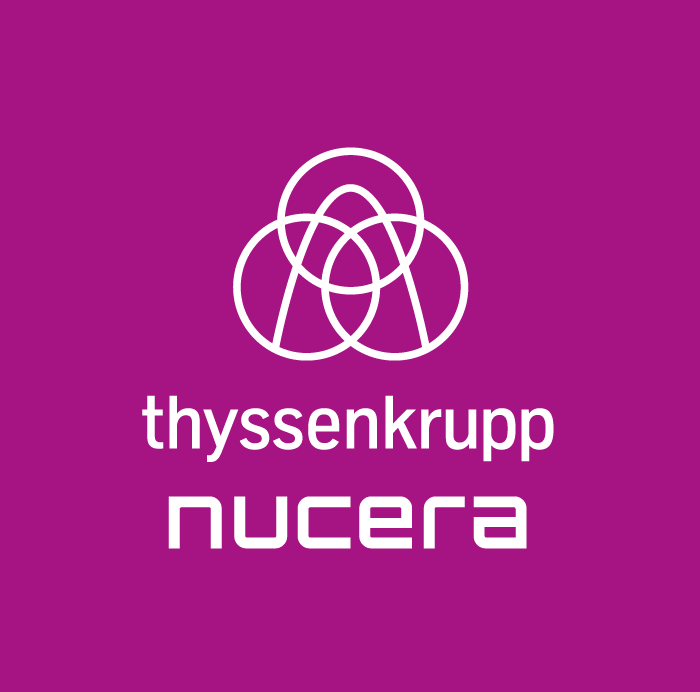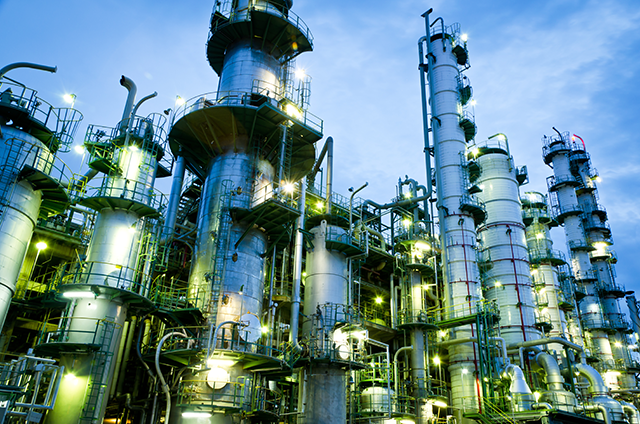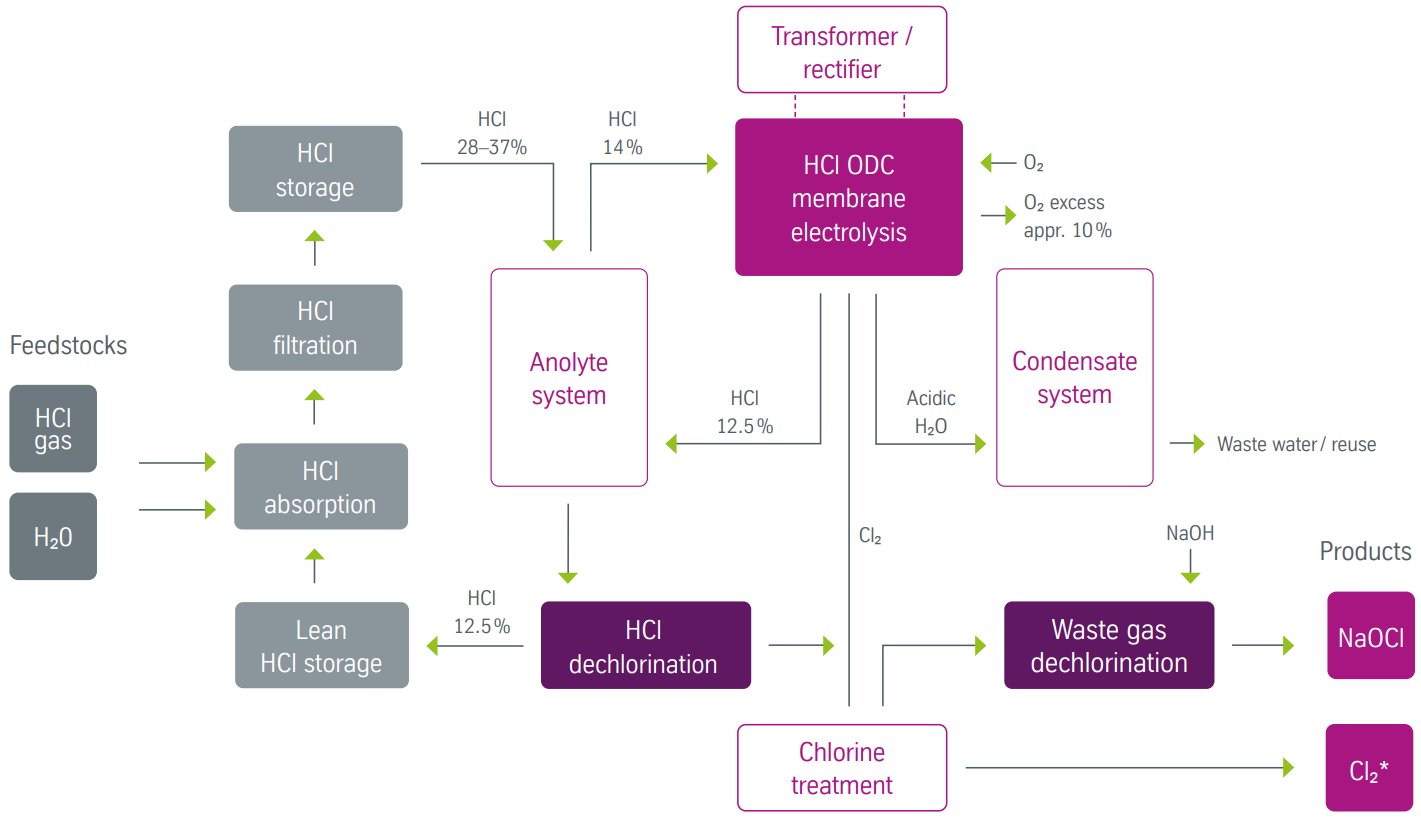Technology Overview
The thyssenkrupp nucera ODC (Oxygen Depolarized Cathode) process represents a novel method in hydrogen chloride (HCl) electrolysis technology, jointly developed with Covestro and De Nora.
The ODC principle is based on the reduction of oxygen at the cathode. The oxygen then reacts with the hydrogen ions, which migrate through the membrane from the anode side of the cell. This suppresses the generation of hydrogen and forms water (H2O):
Chemical equations:
- Anode (oxidation):
- Cathode (ODC reduction):
- Overall:
|
2 Cl⁻ → Cl₂ + 2e⁻
O₂ + 4 H⁺ + 4e⁻ → 2 H₂O
4 HCl + O2 → 2 Cl2 + H2O
|
Compared to the Standard reaction for hydrogen generation, the ODC Process reduces the required operating voltage by approximately 1 volt, resulting in consequent energy savings.
The ODC process find applications in isocyanate plants by recycling HCl from phosgene production, for chlorine recovery from various HCl waste streams, and in integrated chemical complexes where hydrogen is not required.
Electrolyzer Design and Configuration
Figure 1 - HCl electrolysis via the oxygen-depolarized cathode process[3]
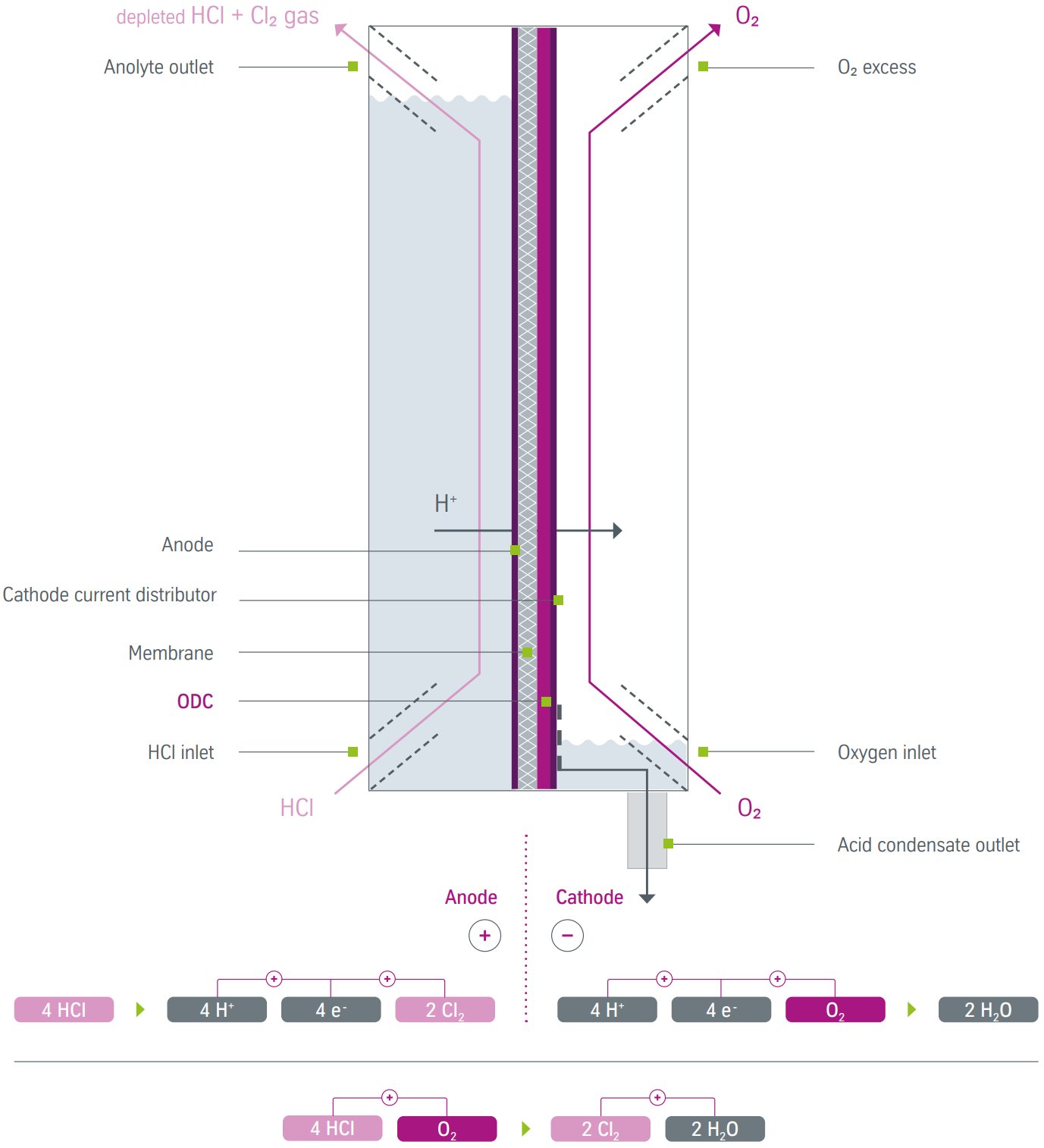
Feed Requirements
- HCl concentration range: 14-37 wt% flexible operation
- Impurity handling: Critical for ODC performance optimization
- Pretreatment options: Stripping, filtration, and active carbon systems
Cell Construction
- Filter-press bipolar electrolyzer design
- Bipolar titanium alloy elements for corrosion resistance
- Gas diffusion electrodes (GDE) with precious metal catalysts
- Membrane separation between anode and cathode compartments
- Vertical slot electrodes for improved gas discharge
- Synthetic material frames resistant to HCl and Cl₂
Oxygen Supply System
- Dedicated oxygen feed to cathode compartment
- Flow control and distribution systems
- Pressure regulation for optimal electrode contact
- Integration with on-site oxygen generation or external supply
Single Acid Circuit
- Simplified process flow compared to dual-circuit diaphragm cells
- 14 wt% HCl feed to electrolyzer
- 12.5 wt% depleted acid recycle to absorption
- No separate catholyte preparation required
Process Control and Monitoring
Operating parameters:
- Current density: 4-6 kA/m²
- Cell voltage: 0.9-1.4 V
- Energy consumption: 733-1070 kWh/t Cl2
- Operating pressure: 200 mbarg anode side
- Temperature: 45-75°C
Advanced Control Systems
- nucera evaluator: Real-time voltage monitoring (125 measurements/second, 3 mV accuracy)
- Automatic HCl concentration control
- Wide operating window adaptable to MDI/TDI process variations
- Remote condition monitoring via Technology Service Center
Safety Features
- No hydrogen production eliminates explosion risks
- Pressure control systems
- Emergency shutdown capabilities
- Corrosion monitoring for equipment protection
Process Flow Diagram and equipment list
Figure 2 - HCl electrolysis ODC process block flow diagram[3]
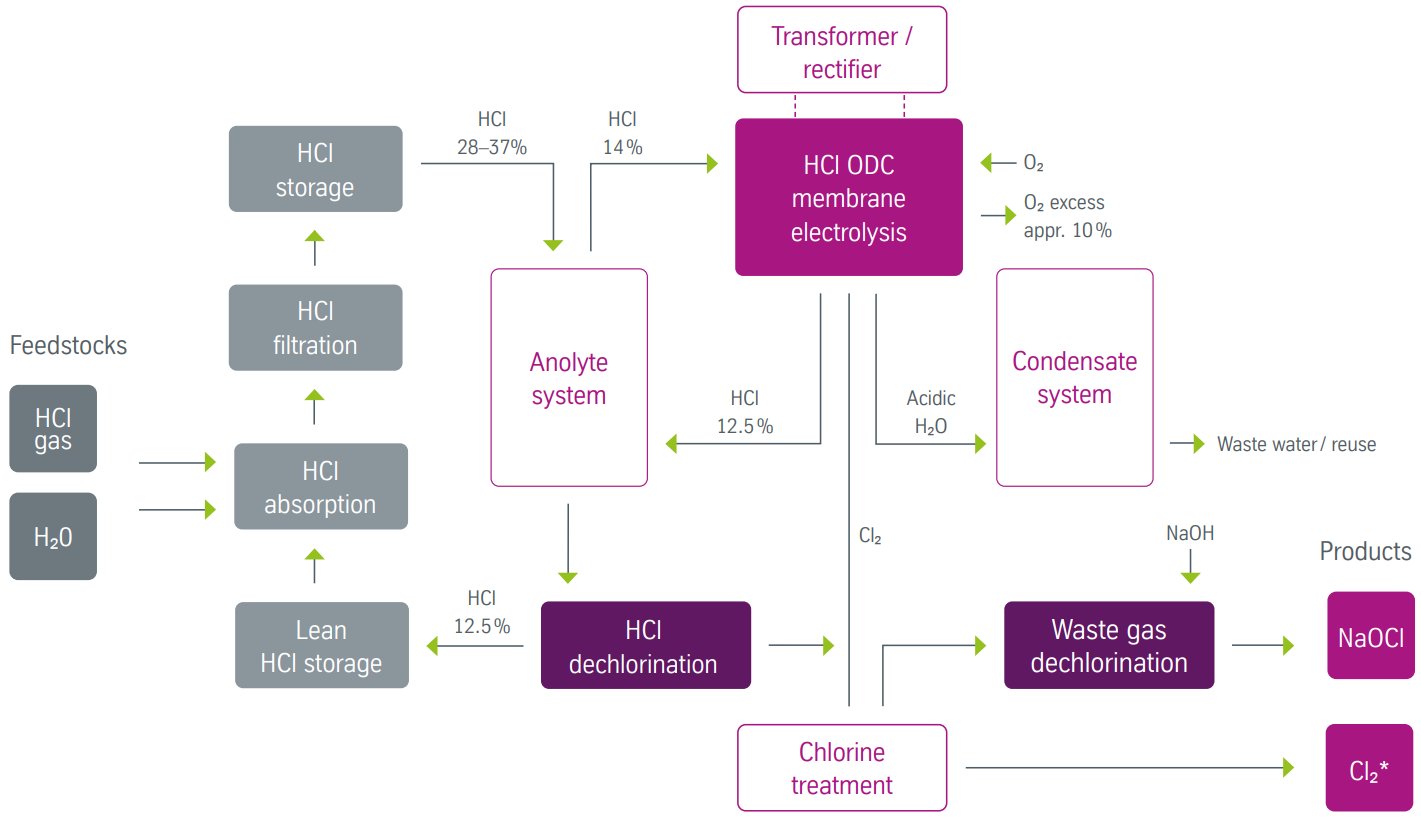
Based on the ODC process description and the standard block flow diagram, the typical equipment list includes the following key components:
- HCl Absorber (Falling-Film or Packed Column): Absorbs anhydrous HCl gas into water or recycled acid to produce aqueous HCl of required concentration.
- Stripping Column: Strips and removes organic impurities from the generated HCl solution.
- Activated Carbon Filters: Adsorbs residual organic impurities and color-forming agents.
- HCl Storage Tanks: Stores concentrated (e.g., 37 wt%) and recycled/depleted HCl solutions.
- Anolyte Tank (Feed Preparation Tank): Maintains and controls concentration (typically ~14 wt% HCl) delivered to the electrolyzer.
- Electrolyzer Stack (ODC Electrolysis Cell): Contains multiple filter-press-type bipolar cells with
- Anode compartment (chlorine evolution)
- Cathode compartment (oxygen reduction)
- Membrane separator
- Gas diffusion electrodes (ODC)
- Oxygen Supply System: Compressors or blowers, supply lines, and distribution headers to feed oxygen to cathode compartments.
- Chlorine-Gas Separator/Collection Header: Separates chlorine gas from depleted acid solution after the anode compartment.
- Acid Circulation and Recirculation Pumps: Handles feed to, from, and within the acid system, e.g. returns depleted (typically ~12.5 wt%) HCl to the tank or absorption section for reconcentration, circulate feed acid stream between units.
- Chlorine Cooling/Condensing System: Cools and removes moisture from raw chlorine gas.
- Chlorine Drying and Purification Units: Dries, filters, and compresses chlorine for storage or directly supplies to downstream processes.
- Oxygen Off-Gas Exhaust and Treatment: Handles small excess oxygen from the cathode chamber.
- Process Instrumentation and Control Cabinets: Automated concentration measurement (titration), flow, pressure, and safety control for the system.
- Auxiliary Heat Exchangers (for cooling circuits): Maintain temperature in absorption and electrolysis sections.
- Process Safety Systems: Hydrogen and chlorine gas monitoring, emergency shutoff valves, pressure relief systems.
Commercial Experience
- Patent foundation: Built on proven single-element electrolysis technology
- Commercial breakthrough: First HCl-ODC plant commissioned in Germany (2001), followed by industrial reference in Yantai Juli-Laiyang, China (2011)
- World-scale milestone: €200 million Covestro's facility in Tarragona represents the first industrial-scale plant operational since February 2023, although plant capacity has not been disclosed.
References
- R Kuwertz et al. Energy-efficient chlorine production by gas-phase HCl electrolysis with oxygen depolarized cathode. Electrochem. Commun., 2013, Vol. 34, pp 320-322. ISSN 1388-2481. DOI 10.1016/j.elecom.2013.07.035.
- G. Polcyn et al. United States patent US9783899B2: Apparatus and method for operating an electrolysis with an oxygen depolarized cathode. Priority date: June 26, 2014. Assigned to ThyssenKrupp Uhde Chlorine Engineers (Italia) SRL.
- thyssenkrupp nucera. Aug 2023. HCl Brochure.
- thyssenkrupp nucera. Hydrochloric Acid Solutions.
- thyssenkrupp nucera.Feb 22, 2023. First world-scale chlorine plant from Covestro with innovative oxygen depolarized cathode (ODC) technology from thyssenkrupp nucera and Covestro in operation.
- Covestro. Feb 6, 2023. Covestro successfully starts up a new world-scale chlorine plant in Tarragona.
- DE NORA. Oxygen Depolarized Cathodes.
